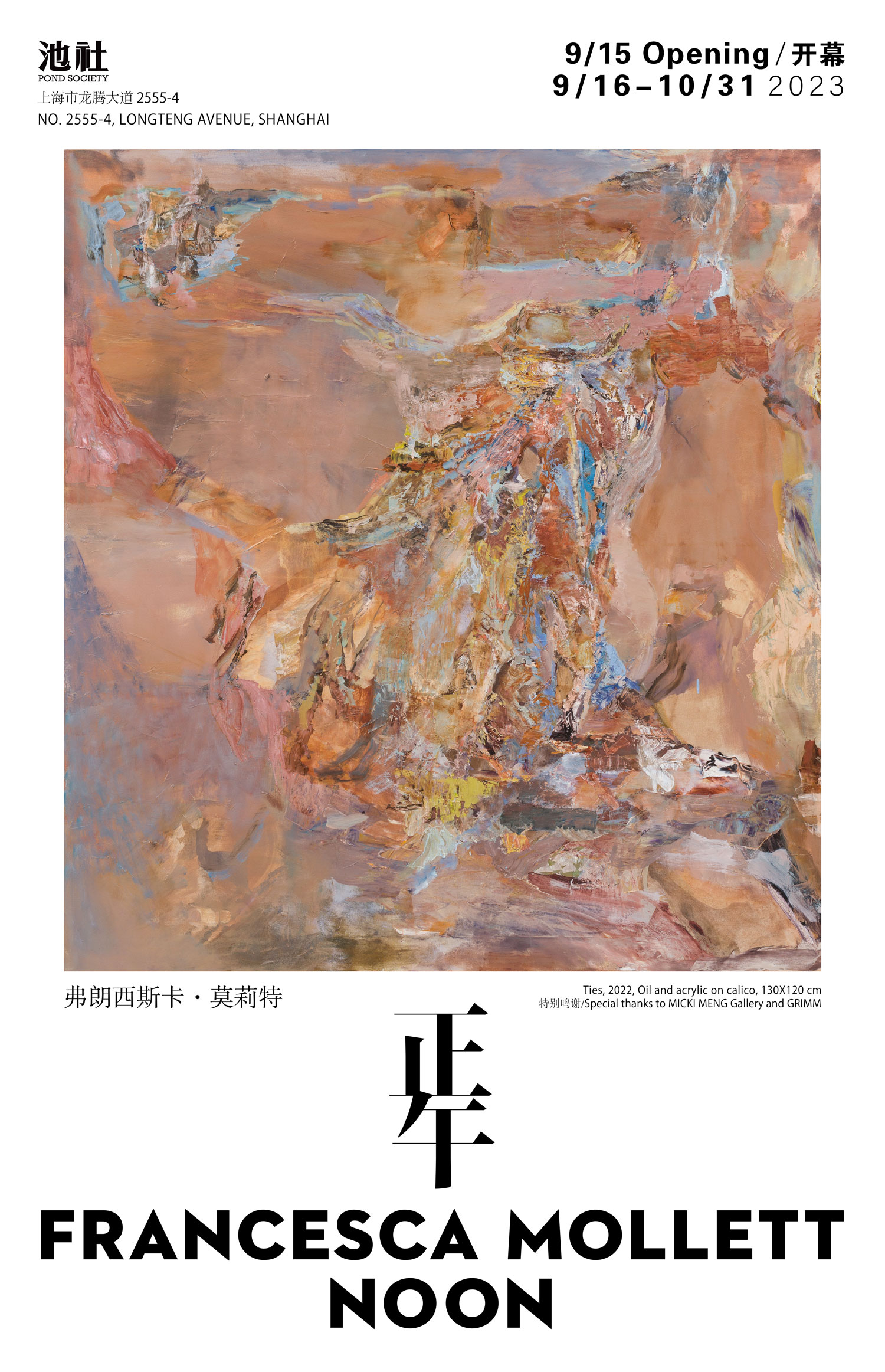展期 Period:
2023.9.16—2023.10.31
艺术家 Artist:
地点 Venue:
新闻稿 Press Release:
池社荣幸地宣布,将举办伦敦艺术家弗朗西斯卡·莫莉特(Francesca Mollett)个展“正午”(Noon)。
莫莉特此前在旧金山 Micki Meng 画廊举办个展“低沉的太阳”(Low Sun)后,“正午”可以视为其姊妹篇,艺术家重新审视和发展自己的想法,并在更广泛的作品中加以实践。这些作品延续了她对于不同颜料浓度的相互作用、以及形态塑造不确定性的探索,在这个意义上,莫莉特的作品可看作一种地质学意义上衰变和积累的语言。
“正午”(Noon)呈现的绘画作品既洋溢着抽象的自由,又充满具象的呼应感,形成一个个鲜明的实体。在这些作品中,物质弥散开去,又交融起来,你中有我,不分彼此。
虽然莫莉特的绘画有一定的内在结构,但它们的构图和形态是多变且富有探索性的。绘画过程始于颜料与粘合剂混调而成的水润但浓烈的色彩,在画面结构中注入更多开放性。在此基础上,不透明区域不断堆叠并向后推移,形成柔和的色调过渡。艺术家用布蘸着颜料,来回涂抹于画面之上。根据下层颜料的干湿程度,有时莫莉特也会借助调色刀来上色,以进一步凸显纹理质地。当上层和下层颜料互相交融,画面张力由此产生。
流动与厚堆形成反差之美,大量细微痕迹凝聚在一起产生爆裂和内破之势。反复的涂抹让画面中浮现出各种或微小或庞大的空间,有些向外凸起,有些则向内凹陷。每一抹痕迹——不论是临时性的、调整性的、破坏性的还是呼应性的——都是与画面互动互联的产物。虽然积小成大的过程或能释放出某种安全感,但其偶然性之中也蕴含着风险:既无法预先排演,又难以回复原貌。
正午时分,太阳当头,高度达到一天之最;正午的白光由全光谱色构成,标志着日复一日来临又逝去的一个高潮时间点。“正午”蕴含着循环对称之意,萦绕于整个展览,赋予画作某种特定性和无限性。当空间溃散、当时间瓦解,经验随着视角的转换、感知的实现和混淆而展开。所有这些在画中汇聚,营造出一种并存的序列感和整体感,赋予观众在“看似奔腾不息,实则静止不动”的绘画前的奇妙体验。
Pond Society is pleased to present Noon, a solo exhibition of paintings by London-based artist Francesca Mollett.
Following her recent exhibition Low Sun at Micki Meng in San Francisco, Noon serves as a sequel; allowing the artist to revisit and develop her ideas into an extended body of work. Continuing her exploration of the interplay between densities of paint, and the uncertain settling of mark into form, these paintings emerge from a geologically inflected language of deterioration and accumulation.
Traversing the freedom of abstraction and the responsive intensity of description, the paintings in Noon coalesce into distinctive entities. Within them, matter disperses and mingles, endlessly divisible and indivisible.
Although an underlying structure is present when Francesca Mollett begins her paintings, their compositions and formations are changeable and exploratory. The painting process begins with a watery but intense colour made of pigment mixed with binder, allowing an openness to the framework laid at the start. From here, opaque areas are built up and pushed back, creating softened, tonal transitions. Colour is rubbed with cloth, smeared across the surface, wiped into and away. It is sometimes applied with palette knife, which - depending on the wetness or dryness of what is underneath - either emphasizes or lifts texture. Surface tensions are created between what is above and beneath as they merge and cross over one another.
Playing with fluidity and mass, multitudes of small marks produce sensations of explosion and implosion. Potentially tiny and enormous spaces that bulge outwards or sink away emerge from zones built up of various types of repetitive touch. Provisional, corrective, destructive or responsive, each mark deals with others made before it. Although a possible safety might be felt in the accumulation of the small, it is also risky in its contingency: it is hard to rehearse, and hard to return.
When the sun seems at its highest but is at its closest, the white light of noon, made from the full spectrum of colours, marks a peak and a point in time that arrives and passes, day after day. Encircling the exhibition with its looping symmetry and softness, the word ‘noon’ identifies in Mollett’s paintings both an encapsulated specificity and an infinitude. Where space crumples and surface frays. Where time collapses and experience unfolds with shifts in perspective and perceptive realisations and confoundments. All this comes together in the paintings, creating a coexisting sense of sequence and all-at-onceness, so that they seem to be moving but still.

